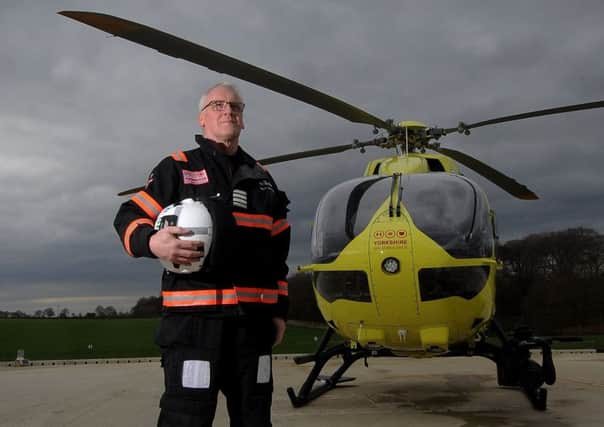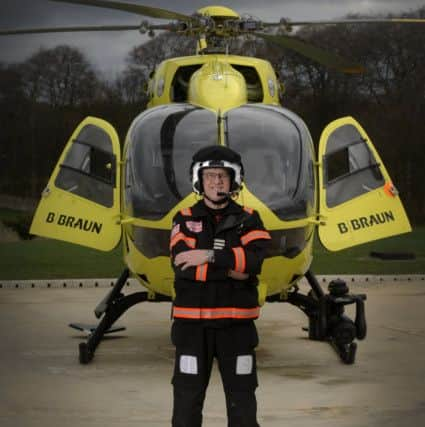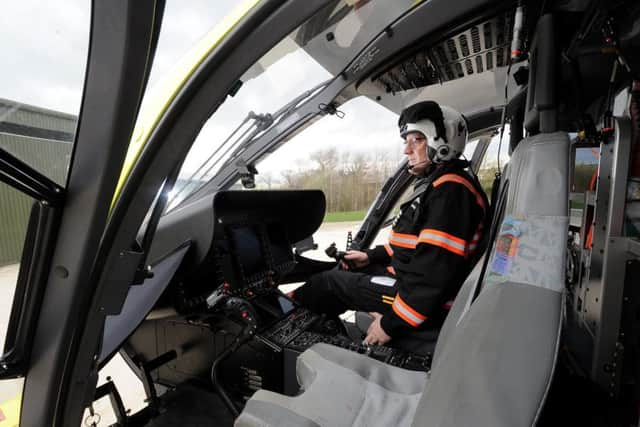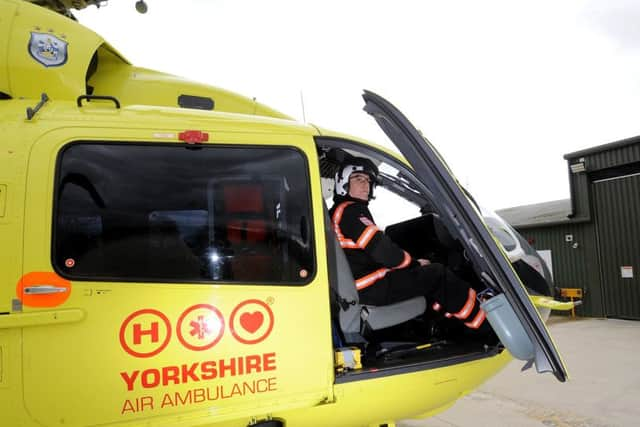Yorkshire Air ambulance pilot relives harrowing life-saving rescues


When a 12 year old Steve Waudby saw a youngster drowning in a flooded quarry he knew instinctively what to do.
It is this instinct and desire to help others that has seen him save hundreds of lives since first as a helicopter pilot in the RAF and latterly as Chief Pilot of the Yorkshire Air Ambulance.
Advertisement
Hide AdAdvertisement
Hide Ad“I was playing near the quarry when a lady shouted that a child was drowning,” recalls dad of two Steve who lives in Pocklington.


“I ran down into the quarry and saw a young child face down in the water about 12ft from the edge. I jumped in and dragged him to the side but was unable to lift him out due to the steep clay banks which were very slippy.
“I had to tread water with him until help arrived. The lady who shouted to me and a teenage boy eventually dragged us both out of the water and the victim was quickly revived.”
The four -year-old boy made a full recovery and Steve was awarded the Liverpool Shipwreck and Humane Society Life Saving Award and the Scouting Gilt Cross for gallantry, he was also invited to meet Her Majesty the Queen and Prince Phillip at Windsor Castle.
Advertisement
Hide AdAdvertisement
Hide AdIt is no surprise really then that Steve would go on to save many more lives and receive more gallantry awards.


Steve’s passion for flying started at a mere age of 13, when he joined the Air Training Corps (air cadets). He went solo in a glider at age 15, became a gliding instructor at age 16, and at 20 won a Royal Air Force flying scholarship, where he obtained his Private Pilot’s license.
He joined the RAF in 1983 where he “fell in love with helicopters” and worked his way up to Squadron Leader, qualifying as a flying instructor and later becoming the senior helicopter instructional standards examiner.
Throughout his 22 years of service, he has flown all over the world including Northern Ireland, Bosnia, Bangladesh and Hong Kong.
Advertisement
Hide AdAdvertisement
Hide Ad“My dad influenced me greatly. He was an engineer in the RAF who also started with the air cadets. The air cadets encouraged me and helped me to develop my flying skills. Without their grants and scholarships I wouldn’t be able to do what I do today.”


During his tour in Hong Kong Steve carried out several air sea rescues in Typhoon and severe tropical storm conditions and was awarded the Edward and Maisie Lewis award for the best search and rescue mission of 1993. He and his crew rescued the crew of a ditched RAF rescue helicopter and 13 Chinese fishermen from a fishing boat in distress in winds gusting to over 100 mph and waves of over 40ft high.
“It was probably the most harrowing rescue I have done,” he admits. “We were in an aircraft that really wasn’t fit for purpose but we took it out anyway because there was nothing else. But when some of your own are involved you will do pretty much anything.”
Although putting themselves at peril Steve and his crew succeeded in rescuing all involved and they were all given the award.
Advertisement
Hide AdAdvertisement
Hide Ad“It was a real team effort and everyone deserved the award which is eligible to people from across the world.”
After 22 years in the RAF Steve returned to Yorkshire and became a private helicopter pilot. First for a race horse owner in York and then for three and half years was former England footballer Michael Owen’s private pilot.
“But when he moved from Newcastle to Manchester United he didn’t need a helicopter to get around anymore and so started doing some work for the Yorkshire Air Ambulance.
“Being a private pilot you are on your own and I missed being part of a team. Rescuing somebody can be the difference between life and death.”
Advertisement
Hide AdAdvertisement
Hide AdWith Yorkshire’s vast rolling landscapes, abundance of farm life and some of the biggest cities in the North, YAA Pilots often have their work cut out.
“We are trained to handle almost any situation, but the most challenging aspects of our job are flying in bad weather, landing in built up areas and flying in mountainous terrain where the winds are unpredictable. Now that we can fly at night, utilising night vision technology, we have to do all of the above in the dark.”
Crews, including paramedics, now make use of a simulator in Germany to do their training, which Steve says has been a big help. Working with traumatic situations can be challenging, not only for the paramedics on scene, but also the pilots who are in charge of ensuring the patient is safely transferred to hospital. “The first couple of jobs I had for the air ambulance were quite horrific with a number of limbs needed to be amputated. You see people suffering, you see children suffering and that is really hard, every time you are going on a job but especially when children are involved you put that extra bit of effort into it.
“Until you get there you have no idea what the situation is going to be and it’s something that we all have to mentally prepare for. But we have a debrief after every job and come together as a team to help anyone who might be struggling. We also work very closely with the other emergency services, it is a team effort from beginning to end.
Advertisement
Hide AdAdvertisement
Hide Ad“We see a lot of dreadful accidents and incidents each week, so it’s important to keep spirits lifted as much as possible and the team are fantastic at supporting each other.”
Although some believe the air ambulance should be part of the NHS, Steve says that would just add too much red tape and detract from their primary aim of helping the public. “Instead if all the 4.5 million people in Yorkshire just donated a £1 that would keep an air ambulance in the air for a year.”
In 2018, the Yorkshire Air Ambulance attended 1,858 incidents across Yorkshire and flew 416 patients to major trauma centres across the county. The Yorkshire Air Ambulance is an independent charity needing to raise £12,000 per day to keep both of Yorkshire’s air ambulances in the air and maintained - the equivalent to £4.4 m each year.
For more information and to support the air ambulance visit www.yaa.org.uk